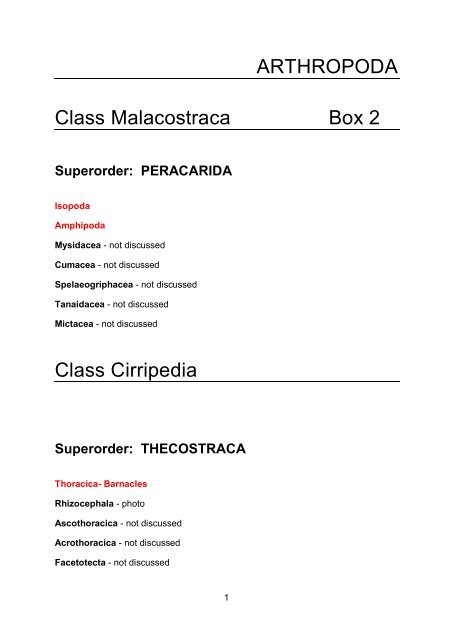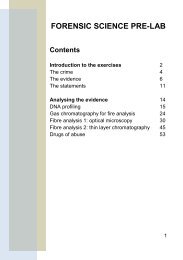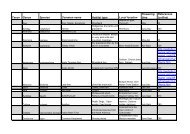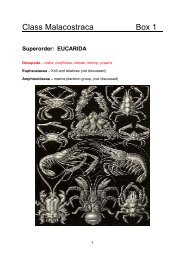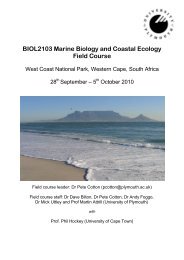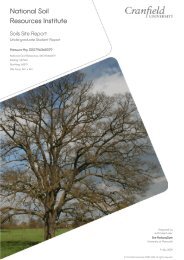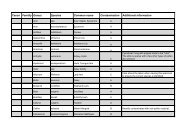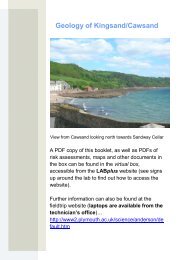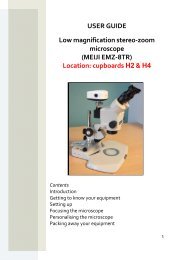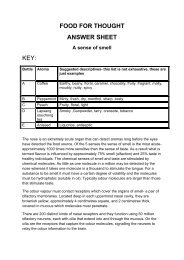Class Cirripedia
ARTHROPODA Class Malacostraca Box 2 Class Cirripedia
ARTHROPODA Class Malacostraca Box 2 Class Cirripedia
Create successful ePaper yourself
Turn your PDF publications into a flip-book with our unique Google optimized e-Paper software.
ARTHROPODA<br />
<strong>Class</strong> Malacostraca Box 2<br />
Superorder: PERACARIDA<br />
Isopoda<br />
Amphipoda<br />
Mysidacea not discussed<br />
Cumacea not discussed<br />
Spelaeogriphacea not discussed<br />
Tanaidacea not discussed<br />
Mictacea not discussed<br />
<strong>Class</strong> <strong>Cirripedia</strong><br />
Superorder: THECOSTRACA<br />
Thoracica Barnacles<br />
Rhizocephala photo<br />
Ascothoracica not discussed<br />
Acrothoracica not discussed<br />
Facetotecta not discussed<br />
1
Index<br />
Getting started………………………………..……………………………………….Page 3<br />
Useful websites……...………………………………………………………………..Page 3<br />
Background Isopoda…………...…………………………………………………….Page 4<br />
Morphological structures of Isopoda…………………………….……....….….…..Page 5<br />
Key to morphological features Isopoda………………………...………………….Page 7<br />
Morphological features of Idotea ……………….………………………………...Page 11<br />
Background Amphipoda………………………….…………………………….…..Page 14<br />
Guide to Amphipod suborder identification……………………………..…….….Page 15<br />
Background Thoracica – Barnacles…………….…………………………………Page 18<br />
Morphological features of Barnacles……………………………………………...Page 19<br />
Photos of barnacles for identification….………………………………………….Page 21<br />
Glossary……………………………………………………………………………...Page 22<br />
List of species in the box…………….………………………..……………………Page 24<br />
2
Getting started<br />
In this box there are common shore crustaceans. Firstly, get a copy of Hayward &<br />
Ryland’s Handbook of the Marine Fauna of NorthWest Europe (from now called<br />
H&R) from shelf C4.3. Go through the identification key to the families (isopoda: pg<br />
340, amphipoda pg 361 and barnacles pg 305) and try to identify them first to family<br />
and then to species level. This booklet will help you by showing some of the key<br />
morphological features of the animals that are used in identification. H&R is a key<br />
that at each step of the identification process gives two options concerning one<br />
morphological feature. Therefore it is called a dichotomous key (dichotomous is a<br />
botanical expression meaning equal branching). Only one of the two descriptions<br />
can be right and then leads to the next question. This booklet shows both options of<br />
each question using drawings, photos or the sample animals, the first option is<br />
illustrated on the lefthand side, the second on the righthand side. Not all features can<br />
or need to be illustrated and are therefore omitted.<br />
While going through the key in H&R you will notice that there are two types of<br />
numbers: the numbers at the end of each option that stand alone are there to guide<br />
you to the next appropriate questions, while the numbers that are followed by a dot<br />
and a family name point you towards the family that the specimen belongs to. When<br />
you decide for an option where a family name is mentioned you then need to<br />
proceed to the key to that family. At the end of the key to families (not family key!)<br />
the section commences where each family has a key. These are numbered and in<br />
order to help orientation you can check the top of the right pages to see which<br />
families are discussed on this particular page.<br />
After you find the species name, compare the number on the mould with the species<br />
list provided at the end of this booklet to see if you identified it correctly.<br />
While studying taxonomy keep in mind that taxonomy is not a rigid science and<br />
different workers may use different taxonomic labels, ie Crustacea can make up a<br />
phylum or be part of the phylum Arthropoda. Also, names change continuously. In<br />
this booklet Gammarus marinus is affected. In H& R it is called Chaetogammarus m.<br />
on the web you will also find Echinogammarus marinus.<br />
Useful websites<br />
http://www.imv.uit.no/amphipod/links.htm, a website linking to websites related to<br />
amphipods<br />
http://www.vims.edu/tcs/, on the left‐hand column (‘Neat society stuff’) click on<br />
‘Crustacean resources’, then scroll down to ‘General crustacea information’, click<br />
on ‘Crustacean classification’ for general taxonomic info<br />
3
http://www.marlin.ac.uk/ for general information on British marine species, find<br />
decapods there<br />
http://www.glaucus.org.uk/Decapoda.htm also for general marine life around UK<br />
waters<br />
http://crustacea.net/ where you can download an interactive ID key, which will<br />
illustrate some key features of taxonomy<br />
http://crustacea.nhm.org/glossary/ a glossary for all the scientific terms used in<br />
crustacean ID, have a look but it is very extensive<br />
http://nlbif.eti.uva.nl/bis/crustacea.php a Dutch website introducing crustaceans<br />
of the North Sea with some very good descriptions, a key and a glossary ‐ worth<br />
checking out!!<br />
Background Isopoda<br />
Isopods are the most diverse in form and the most speciesrich crustaceans of the<br />
Peracarida. They occur in nearly all environments and marine isopods can be found<br />
from the intertidal to the deep sea. Approximately 10 000 species have been<br />
described in 10 suborders. These animals range in length from 0.5 mm to 500 mm<br />
(Bathynomus giganteus). Phylogenetic analyses and the fossil record (limited though<br />
it is) suggest that the group dates to at least the Carboniferous Period of the<br />
Paleozoic, approximately 300 million years ago.<br />
Isopods are dorsoventrally flattened crustaceans without a carapace. The body is<br />
divided into a cephalon (head), a pereon (thorax) with seven segments and a pleon<br />
(abdomen) with six segments. Figure 1 illustrates the key morphological features of a<br />
generalised isopod. If you study this drawing you will get familiar with the main<br />
distinguishing features which will help you later in the identification of isopods.<br />
Using this booklet and the specimens provided, try to identify the animals to species<br />
level. Use the glossary at the end of the booklet to look up terms mentioned in the<br />
identification process, else the glossary website mentioned above is an excellent<br />
source of information. Beware that sometimes different words can be used for the<br />
same anatomical feature, for example coxa and coxopodite. Where possible, in this<br />
booklet the scientific terms were used, making it harder but you will be rewarded for<br />
sticking with it when you get to identify animals on the seashore using books like<br />
Hayward & Ryland.<br />
4
Figure 1: A generalised isopod with the distinguishing features (from Kensley, B. and Schotte, M. (1989)<br />
Guide to the marine isopod crustaceans of the Caribbean. Smithonian Institution Press, Washington D.C.<br />
Arrows indicate where the removed parts to the right belong within the isopod.<br />
5
Figure 2: Drawing of a thoracic leg (From: Holthuis, L.B. 1993. The Recent genera of the caridean and<br />
stenopodidean shrimps (Crustacea, Decapoda): With an appendix on the order Amphionidacea.<br />
Nationaal Natuurhistorisch Museum Leiden. 328pp)<br />
6
ISOPODA<br />
Pg. 341 in Hayward & Ryland<br />
Option 1 Question 2 Option 2<br />
Pereopod 15<br />
Pereopod 17<br />
Ventral view of an isopod with<br />
5 pereopods, see CM3001!<br />
Ventral view of CM3004<br />
7
Question 3<br />
Uropods lateral<br />
Three distinctly<br />
different places<br />
for the uropods,<br />
See if you can<br />
identify this<br />
feature in all<br />
specimens<br />
provided and sort<br />
them<br />
accordingly!<br />
Uropods terminal<br />
Uropods ventral<br />
8
Option 1 Question 4 Option 2<br />
Check out the drawing at Figure 8.12 in the book, compare the<br />
flabelliferan isopod with the valviferan isopod because the drawings<br />
are more accurate than the pictures below. Divide your specimens into<br />
the two groups and follow the key further!<br />
Question 5<br />
Size does not matter, but do the legs<br />
look alike(ish)?<br />
Which of the species you have left has<br />
this particular feature?<br />
Ambulatory: can be used for walking.<br />
9
Question 69 are not discussed in this booklet<br />
Question 10<br />
If you are left with only one specimen, you did well! This<br />
specimen is considered terrestrial though it is found around<br />
HWM of rocky shores.<br />
Pleon segment 16<br />
Head of CM3007<br />
Flagellum with segments<br />
If you identified the last critter as a member of the Ligiidae family<br />
you did well and can continue with the right family key!<br />
10
Idotea<br />
Pg 349<br />
As there are several species of Idotea in this box we will continue with<br />
these to species level, and using the sources given you might want to<br />
identify the other specimens to species level too. You can check if you<br />
are right by looking at the species list on the end of the booklet!<br />
Option 1 Question 1 Option 2<br />
Body of an isopod, dorsal view<br />
Please refer to Fig. 8.23<br />
in H &R for the first option<br />
(Synisoma)<br />
Pleon with two distinct segments, one<br />
partially fused, the others completely<br />
fused with telson, see drawing below!<br />
11
Option 1 Question 3 Option 2<br />
While in Question 1 we were asked if there is a segmentation at all or<br />
not, now we are interested in the number of segments of the pleon, or<br />
pleotelson.<br />
Body of an isopod, dorsal view<br />
Pleon with two distinct segments<br />
and one partial suture<br />
Question 4<br />
Pleotelson: 4 possible shapes of the apical border<br />
Apical border<br />
Straight Concave Produced Angulate<br />
Continue with question 7!<br />
12
Question 5+6 omitted<br />
Option 1 Question 7 Option 2<br />
Check the drawing of Idotea<br />
baltica in Figure 8.22 in the<br />
book<br />
The sides of the telson are<br />
rounded as in the drawing<br />
of Idotea emarginata, Fig.<br />
8.22<br />
Question 8<br />
Pleotelson slightl<br />
convcave (marked<br />
in red with an<br />
acute median<br />
process(=tip in the<br />
middle)<br />
Pleotelson with<br />
convex apical<br />
margin (marked<br />
in red)<br />
Antennule<br />
Question 9<br />
Peduncle<br />
Flagellum<br />
Antennule and antenna, the<br />
peduncle of the antennule has 3<br />
articles, while the antenna<br />
peduncle has 5. See also<br />
Figure 1 on page 5 in this<br />
booklet.!<br />
Antenna<br />
Have you managed to identify all specimens correctly?<br />
Well done!<br />
13
Background Amphipoda<br />
Amphipods and isopods have many characters in common such as the lack of a<br />
carapace, however generally the body of an amphipod is laterally flattened while that<br />
of an isopod is dorsoventrally flattened. Before you continue reading open H&R to<br />
page 363 and study the drawing of a generalised amphipod on the top of the page.<br />
Note the taxonomic terms used and where they occur. This will help you when you<br />
then turn your attention to the key and the specimens provided in the box.<br />
The body of an amphipod is divided into three regions: the head, the pereon (thorax)<br />
and pleon (abdomen) with a telson attached to the last pleon segment. The head<br />
bears six pairs of appendages: antenna 1 and antenna 2, mandibles, maxillae 1 and<br />
maxillae 2 as well as maxillipeds., the pleon has seven visible segments each with a<br />
pair of uniramous (lacking either the exopod or endopod) appendages, the<br />
eperopods, where pereopods 1 and 2 are modified as gnathopods. Of the seven<br />
externally visible thorax segments, the first two bear appendages known as<br />
gnathopods used in feeding and grasping. While the remaining segments of the<br />
thorax bear pereopods. In many amphipods the gnathopods are subchelate (see<br />
Figure 8.26 in H&R).<br />
Body forms vary greatly within the amphipods but the most remark divergence<br />
occurs in the Caprelllidea. They have long cylindrical bodies and a reduction in<br />
number and type of appendages.<br />
14
Examples of key<br />
morphological features<br />
Suborders of Amphipodapg 361<br />
Question 1 Option 1<br />
In Caprellids the pleon (abdomen) is usually no longer present and no<br />
pleopods exist,gnathopod 1 is attached to the head which is fused with<br />
the first segment of the thorax, no uropods either, the gills are paddle<br />
shaped appendages along the body..<br />
15
Question 1 Option 2<br />
You can see a difference between thorax and<br />
abdomen, if you look at the coxa and the appendages<br />
of either part of the body<br />
Proceed to Question 2<br />
16
Option 1 Question 2 Option 2<br />
Hyperiidae: notice the large<br />
eye and rounded body.<br />
None of these groups will be identified to species level<br />
as this would be too much for this booklet. Still, a lot of<br />
research from this University is done on them and for<br />
this reason it is a good idea to learn to identify them.<br />
Three species are provided for that.<br />
17
Background Thoracica – Barnacles<br />
Barnacles are exclusively marine. They are so ubiquitous, especially on the upper<br />
reaches of most rocky shores, that they form a distinct greywhite line marking the<br />
upper limit of the eulittoral. They have three life stages, a planktonic, feeding<br />
nauplius larva, which metamorphoses into a shrimplike nonfeeding cyprid. The<br />
cyprid has one pair of antennae, with which it finds suitable habitat on a hard<br />
substrate to settle. They show a highly selective settlement behavior, and will choose<br />
a place close to adults of their species. A secretion from the antennae cements the<br />
cyprid to the rock where they then metamorphose within 24 hours into a juvenile.<br />
During spring brown cyprids of Semibalanus balanoides settle on the rocky shores<br />
around Britain, they are just visible to the naked eye. Chthamalus settle in the<br />
summer and early autumn. Their six thoracic biramous appendages are then used to<br />
filter particles out of the water.<br />
An important feature in identification are the calcareous plates that make up the<br />
sides of their bodies. These will – with time – grow together, making the plates<br />
difficult to distinguish. Keep that in mind when identifying barnacles on the seashore<br />
and with time you will get an eye for all the species.<br />
A: Distinct plates B: Plates grown together<br />
Before working with the key, turn your attention to Figure 8.6 on page 303 and<br />
study the two bottom drawings so you know the taxonomic terms for<br />
barnacles. There are no specimens in the box but you can use the photos in<br />
this booklet for identification.<br />
18
Thoracicapg 304<br />
Start at the key to Families<br />
Option 1 Question 1 Option 2<br />
One of 6 calcerous plates<br />
Rhizocephala, no clacereous<br />
plates, endoparasite on a<br />
decapod<br />
Question 2<br />
Capitulum<br />
(=head)<br />
Peduncle<br />
(=stalk)<br />
Operculum<br />
See how the barnacle is<br />
firmly attached to the<br />
substrate, lacking a stalk<br />
19
Question 3 omitted<br />
Option 1 Question 4 Option 2<br />
Verrucaridae, see also<br />
Fig 8.8 in H&R<br />
4 plates clearly<br />
visible in the<br />
center, making up<br />
the operculum<br />
Question 5<br />
Rostrum<br />
Rostrum<br />
You can now proceed to the respective family keys!<br />
20
Now, please identify the barnacles below:<br />
CM3009<br />
CM3012<br />
CM3010<br />
CM3013<br />
CM3011<br />
21
Glossary<br />
Aesthetasc Sensory part of the<br />
antenna and antennule<br />
Ambulatory Used for walking<br />
Antenna Mobile sensory appendages<br />
arising below the eyes at the front of<br />
the head, located outside the<br />
antennules<br />
Antennule Inner of two paired<br />
flagellate appendages projecting from<br />
anterior end of body<br />
Anterior Front end of organism or<br />
head end<br />
Appendage A general term for a body<br />
part attached to a body segment such<br />
as a leg or antenna<br />
Bifid A structure with two distal tips<br />
Biramous Having two branches or<br />
rami (exopod and endopod), some<br />
arthropod legs have two parts an inner<br />
and an outer branch<br />
Carapace A shield that covers the<br />
head and thorax of crustaceans where<br />
the thoracic segments have fused<br />
Chelate, chela An appendage in<br />
which the movable dactylus is<br />
opposed to an equally welldeveloped<br />
distal prolongation of the propodus,<br />
basically the ‘claw’ (Figure 2 depicts<br />
the parts of an arthropod leg)<br />
Cheliped The walking leg that bears<br />
the chela<br />
Concave Curving in or having a dent<br />
22<br />
Convex Curving or bulging outward<br />
Coxa First article of a limb as<br />
Figure 2<br />
Coxal plate The coxa is a part of the<br />
leg (see Fig. 2), in some isopods and<br />
amphipods this is expanded to form a<br />
lateral plate<br />
Cuticle Forms the exoskeleton<br />
Distal Further from the body, ie in the<br />
human leg the toe is distal while the<br />
knee is more proximal<br />
Dorsal Top of an animal<br />
Flagellum A long, multisegmented<br />
sensory appendage found attached to<br />
the peduncle of the antennae and<br />
antennules<br />
Flagellate Resembling a flagellum,<br />
whiplike extension of the antenna<br />
Lateral The sides of an animal<br />
Maxilla One of two paired appendages<br />
in mouth region, posterior to (above in<br />
ventral view) mandible<br />
Maxilliped Mouth appendage, there<br />
are three pairs of maxillipeds plus 3<br />
pairs of other mouth appendages<br />
Maxilliped, 3 rd the outermost mouth<br />
appendage in crustaceans and used in<br />
identification in some crustacean<br />
groups<br />
Median lobe The middle lobe of the<br />
frontal region of the carapace (mainly<br />
in decapods)<br />
Peduncle 1. Proximal (close to the<br />
body) division of antennule or antenna.
Typically consists of three segments in<br />
antennule, five segments in antenna<br />
2. Stalk supporting the head<br />
(capitulum) of lepadomorph barnacles<br />
3. Sometimes used for the eye stalk in<br />
shrimp<br />
Pereopod, periopod an appendage of<br />
the thorax used for movement,<br />
feeding, and defense<br />
Pereon Thorax<br />
Pleon Abdominal region of the body,<br />
primitively consisting of six segments<br />
or pleonites, and bearing paired<br />
pleopod and uropod appendages<br />
Pleopod Appendages attached to the<br />
abdominal segments<br />
Pleotelson Structure formed by fusion<br />
of one or more abdominal somites with<br />
telson, as in most isopods<br />
Pleura Lateral plates forming a ring<br />
with the sternum and the tergum<br />
around decapods’ abdomen<br />
Proximal Closer to the body, eg in the<br />
human leg the knee is proximal while<br />
the toe is distal<br />
Quadrangular Shaped like a square<br />
or diamond<br />
Sclerite Articulated plates around the<br />
abdomen of decapods<br />
Seta A hair arising from the outside of<br />
the exoskeleton<br />
Somite Single body segment,<br />
especially of the abdomen<br />
Subchelate The last segment of an<br />
appendage closes against the<br />
preceding segment (see Fig. 8.26 in<br />
H&R)<br />
Suture a junction between two hard<br />
parts of the exoskeleton<br />
Tergum Dorsal (top) plate of the<br />
abdomen of crustaceans<br />
Tridentate Possessing 3 teeth or<br />
prongs<br />
Uniramous An appendage having<br />
only one branch, so either lacking the<br />
endopod or the exopod (see biramous)<br />
Uropod Part of tail fan; a paired<br />
biramous (having two parts)<br />
appendage borne on the sixth<br />
abdominal somite (body segment)<br />
Ventral Underside of an animal<br />
Vestigial A body part that is small,<br />
degenerated or not fully developed<br />
23
Phylum Crustacea <strong>Class</strong> Malacostraca Box 2: CM300113<br />
Mould number……………………….Family………………………………………Species<br />
CM3001 Gnathiidae Gnathia sp.<br />
(May only be present in one box)<br />
CM3002 Idoteidae Idotea pelagica<br />
CM3003 Idoteidae Idotea baltica<br />
CM3004 Idoteidae Idotea granulosa<br />
CM3005 Sphaeromatidae Dynamene bidentata<br />
CM3006 Corophiidae Corophium volutator<br />
CM3007 Ligiidae Ligia oceanica<br />
CM3008 Gammaridae Gammarus marinus<br />
CM3009 Chthamalidae Chthamalus montagui<br />
CM3010 Balanidae Elminius modestus<br />
CM3011 Balanidae Semibalanus balanoides<br />
CM3012 Balanidae Balanus balanus<br />
CM3013 Chthamalidae Chthamalus stellatus<br />
24


